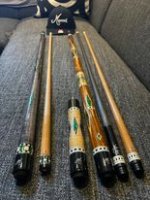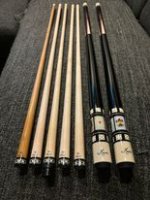I most admire cue makers who can balance out a cue to specific weights without using metal weight bolts- Mike Capone comes to top of mind- it takes true skill to do this as opposed to just add chunks of metal to the back of a cue butt.I think the way you did it worked for you to get more forward weight in the cue but was not a whole lot different than adding that .3 oz on the butt side of the joint pin. I don't think it would help him with feeling like he was had a 4 oz shaft riding through his bridge hand.
The idea of drilling out cue shafts and adding chunks of metal inside a cue shaft to make a desired weight - now THAT seems really scary to me! I like my cue shafts as evenly balanced across the entire shaft as I do with the back end of a cue - the less metal additions to a cue, IMO, shows true custom building as opposed to production shop economy assembly line end results.


